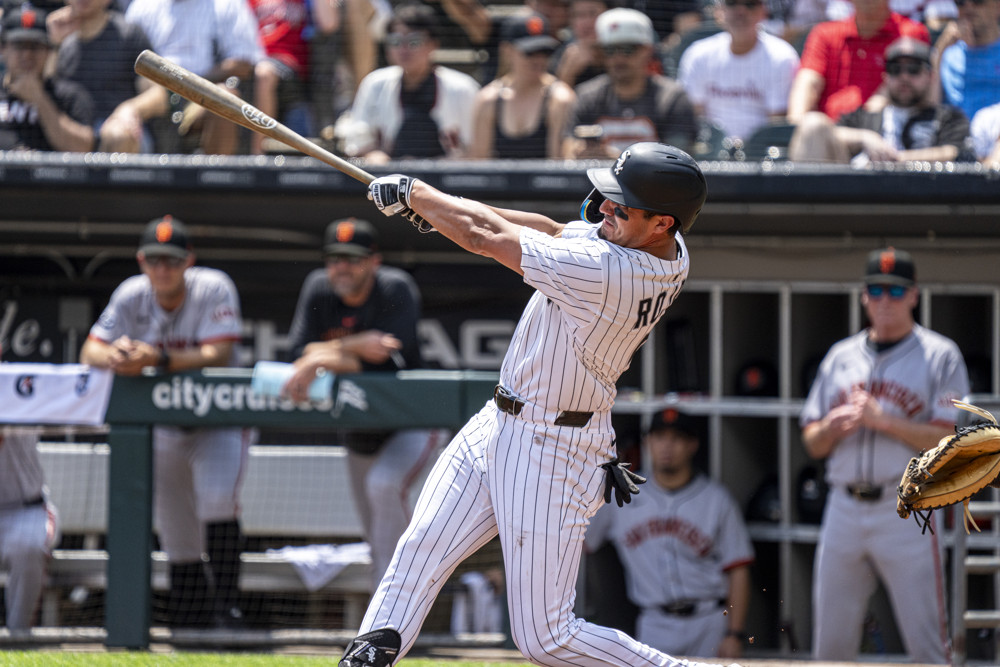Asking "Who closes for the White Sox now?" is...
A) An irrelevant question for a roster of the 2024 team's caliber, as clearly evidenced by the club so willingly dealing Gregory Santos less than two weeks before spring camp opens.
B) An efficient way to suss out the bullpen hierarchy, or lack thereof, less than two weeks before spring camp opens.
C) Both, obviously, since otherwise there would be no point to structuring the introduction this way. It's also a question the White Sox are not capable of answering quite yet.
"It takes a little bit of time for the identities of the bullpen to kind of take shape in regards to different roles," Chris Getz said on Saturday. "Time will tell."
Tim Hill's four career saves makes him the current leader on the White Sox 40-man, but that credential does not change his identity as a medium-leverage lefty specialist looking for a rebound season. John Brebbia's two career saves both came over five years ago, but recent performance and bat-missing ability probably makes him the safest point to start the leverage ladder. Sound off in the comments on whether Jimmy Lambert having a save or that he turns 30 later this year is the more surprising factoid.
With apologies to Deivi García's one career save and Tanner Banks weathering a bases-loaded walk before closing out a 7-6 win over the Twins last September, this is where the trail of leverage experience or even easy candidates to make the Opening Day roster start running cold. Joe Barlow has 24 career saves and a meaningful stint as the Rangers closer just two seasons prior, but in a demonstration of the folly of trying to sort the Sox bullpen by track record, he has to worry about reversing a two-year decline in whiffs to make the team first. As assembled, the White Sox bullpen will be defined by...
A) Likely very poor performance in a season where efficiently securing marginal wins won't be very important to the front office's goals.
B) An open forum for Bannister and a different-looking White Sox pitching development program to demonstrate their ability to turn untapped talent into major league contributors.
C) These are really functioning as lists rather than multiple choice.
It's easy for someone who has been half-watching this organization for the last seven months to roll off the couch and say "Bannister'll fix 'em" looks like how the Sox plan to scrap together a rebuilding bullpen, but it's also what the GM is quickly alluding to when questions on the topic float his way.
"We will certainly be creative with how we deploy our pitching," Getz said. "I’ve had a lot of conversations this offseason whether it’s how we are going to use some of our arms and also whether it be Brian Bannister our others, finding players who fit in our style."
Last season's deadline acquisition, right-hander Jordan Leasure and his high-slot riding four-seamer, is an easy first option for a litmus test on the team's ability to quickly convert high-ended stuff into a high-leverage arm with improved strike-throwing and slider execution. Prelander Berroa, having already made his big league debut but lacking much history of harnessing his slider-first attack and upper-90s fastball in the zone, arrives in a similar place as Santos was this time last year. At least enough so Berroa is listed at a sprightly 5-foot-11 and lives at the top of the zone rather than sinking the ball, and Getz still made note of his similarities with the man he was traded for. Offseason waiver claim Alex Speas, just 25, is also of a similar mold with a cutter-heavy approach despite top-of-the-scale velocity, with the least strike-throwing of the trio.
All read as the sort of building materials fit for a team that chose take-home assembly for their leverage arms rather than get stuck paying the delivery fees, and is willing to accept a reality where they never figure out what the extra screws at the bottom of the box are for, or what's causing that weird squeaking noise. Given the likely success rate, they need more options, and the Sox have yet to announce their full slate of non-roster camp invitees, leaving us to spend too much time pondering what mid-career adjustments are feasible for the likes of minor league signings Chad Kuhl and Justin Anderson.
Three years after the White Sox determined Garrett Crochet was too immediately essential to the major league relief corps to develop as a starter, flipping that approach when the odds of success appear slimmer already was a strong enough statement on the lower priority of the assured results from the bullpen this year. But in terms weighing the cost of current bullpen competency for more long-term considerations, Getz indicated that the value of acquiring the 69th overall pick was specifically quantified as worth the potentially ugly fallout.
"It's exciting," Getz said. "Being able to trade draft picks is fairly new, and to properly value each draft pick, we have our system to be able to understand what each pick is worth beyond just the slot amount. But it gives you some flexibility throughout those 10 rounds to maximize."
Even that is a break from the larger thrust of the White Sox tearing up their major league roster since last July. At the risk of giving bulletin board material to Maximo Martinez, the Sox have not acquired any potential impact contributors less advanced than Double-A in that time. While the 2024 roster -- certainly its current bullpen -- show few signs of it, they have traded like a team looking for a quicker flip in their fortunes rather than a full-gut rehab.
Whether the developmental infrastructure is in place to make this Sox bullpen less doomed than it appears could be a half-decent barometer of how feasible a quicker recovery timeline could be. As easy as it is to say that protecting leads doesn't matter in a rebuilding year, it's amazing how one unit of a team becoming completely non-functional can put strain on others. If Jim is right and the best thing the White Sox can do this season is get through it as quickly as possible, somebody in that bullpen is going to have throw strikes.





